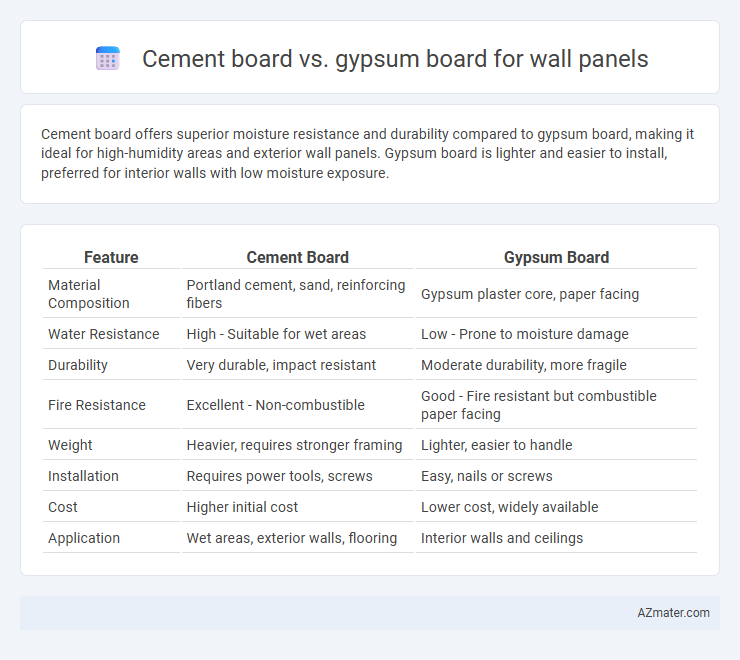Cement board offers superior moisture resistance and durability compared to gypsum board, making it ideal for high-humidity areas and exterior wall panels. Gypsum board is lighter and easier to install, preferred for interior walls with low moisture exposure.
Table of Comparison
| Feature | Cement Board | Gypsum Board |
|---|---|---|
| Material Composition | Portland cement, sand, reinforcing fibers | Gypsum plaster core, paper facing |
| Water Resistance | High - Suitable for wet areas | Low - Prone to moisture damage |
| Durability | Very durable, impact resistant | Moderate durability, more fragile |
| Fire Resistance | Excellent - Non-combustible | Good - Fire resistant but combustible paper facing |
| Weight | Heavier, requires stronger framing | Lighter, easier to handle |
| Installation | Requires power tools, screws | Easy, nails or screws |
| Cost | Higher initial cost | Lower cost, widely available |
| Application | Wet areas, exterior walls, flooring | Interior walls and ceilings |
Introduction to Wall Panel Materials
Cement board and gypsum board are popular wall panel materials used in construction for different applications. Cement board is composed of cement and reinforcing fibers, making it highly durable, moisture-resistant, and ideal for wet areas such as bathrooms and kitchens. Gypsum board, made from a gypsum core sandwiched between paper layers, offers ease of installation, fire resistance, and smooth finishes suitable for interior walls and ceilings in dry environments.
What is Cement Board?
Cement board is a durable building material composed of cement and reinforcing fibers, designed to provide superior moisture resistance and structural stability for wall panels. It is commonly used in areas exposed to water, such as bathrooms and kitchens, due to its resistance to mold, mildew, and rot compared to gypsum board. Cement board serves as an ideal substrate for tile installations, enhancing longevity and performance in wet or high-humidity environments.
What is Gypsum Board?
Gypsum board, also known as drywall or plasterboard, is a panel made of calcium sulfate dihydrate (gypsum) pressed between thick sheets of paper, widely used for interior wall and ceiling applications due to its fire-resistant and soundproofing properties. It offers smooth surface finishes, easy cutting and installation, and is cost-effective for residential and commercial buildings. Unlike cement board, gypsum board is less moisture-resistant, making it less suitable for wet or exterior environments.
Key Differences Between Cement Board and Gypsum Board
Cement board is a durable, moisture-resistant material composed of cement and reinforcing fibers, ideal for wet areas like bathrooms and kitchens, while gypsum board consists of a gypsum core encased in paper, suited for dry interior walls and ceilings. Cement board provides superior impact resistance, mold resistance, and fire resistance compared to gypsum board, which is more lightweight and easier to cut and install. The key differences lie in their moisture resistance, durability, and installation suitability, making cement board preferable for high-moisture environments and gypsum board better for general interior partitions.
Durability and Strength Comparison
Cement boards exhibit superior durability and moisture resistance compared to gypsum boards, making them ideal for high-humidity areas such as bathrooms and kitchens. With a density typically around 1,600 kg/m3, cement boards provide higher impact resistance and structural strength, supporting heavy loads without deformation. In contrast, gypsum boards, with densities near 700-900 kg/m3, are more prone to damage from water exposure and physical impact, limiting their use to dry interior walls.
Moisture and Fire Resistance
Cement boards exhibit superior moisture resistance compared to gypsum boards, making them ideal for wet environments such as bathrooms and kitchens. Fire resistance is also enhanced in cement boards due to their non-combustible properties and high thermal stability, whereas gypsum boards offer moderate fire resistance primarily through their chemically bound water content. For wall panels in areas prone to moisture and fire risk, cement boards provide a more durable and safer solution.
Installation Process and Ease
Cement board installation requires cutting with a carbide-tipped scoring tool and fastening with corrosion-resistant screws, which can be more labor-intensive due to its weight and rigidity. Gypsum board is quicker to install using standard drywall tools, with easy scoring and snapping, and lightweight sheets that reduce handling fatigue. The ease of installation for gypsum board often makes it preferable for interior wall applications, while cement board's durability suits moisture-prone areas despite a more demanding installation process.
Cost Comparison
Cement boards typically cost between $12 and $20 per 3x5-foot sheet, making them more expensive compared to gypsum boards, which range from $8 to $15 per similar-sized sheet. The higher price of cement boards reflects their superior durability, moisture resistance, and suitability for wet areas, whereas gypsum boards are more affordable and commonly used for interior walls in dry environments. Long-term costs for cement boards may be offset by reduced maintenance and repair expenses in moisture-prone locations.
Best Applications for Cement and Gypsum Boards
Cement board excels in moisture-prone areas such as bathrooms, kitchens, and exterior walls due to its water resistance and durability, making it ideal for tiling substrates and wet environments. Gypsum board is best suited for interior walls and ceilings in dry locations, offering ease of installation, smooth finishes, and excellent fire resistance properties. Choosing cement board for wet or high-impact areas and gypsum board for standard interior partitions ensures optimal performance and longevity.
Which Wall Panel Option is Right for You?
Cement board offers superior moisture resistance and durability, making it ideal for wet areas like bathrooms and kitchens, while gypsum board provides excellent fire resistance and soundproofing for interior walls. For areas prone to water exposure or heavy wear, cement boards ensure longevity and structural integrity, whereas gypsum boards are cost-effective and easier to install for standard drywall applications. Evaluating the specific environmental conditions and usage requirements of your space will help determine whether cement or gypsum board is the optimal wall panel choice.

Infographic: Cement board vs Gypsum board for Wall panel
 azmater.com
azmater.com